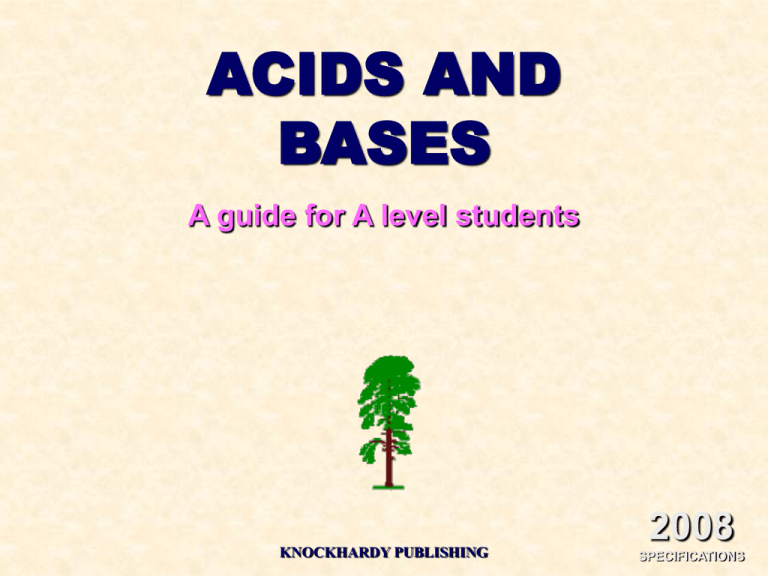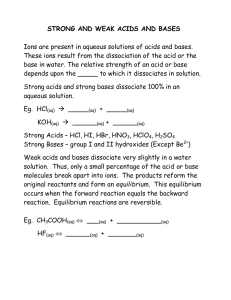ACIDS AND BASES 2008 A guide for A level students
advertisement

ACIDS AND BASES A guide for A level students KNOCKHARDY PUBLISHING 2008 SPECIFICATIONS Acid & Bases INTRODUCTION This Powerpoint show is one of several produced to help students understand selected topics at AS and A2 level Chemistry. It is based on the requirements of the AQA and OCR specifications but is suitable for other examination boards. Individual students may use the material at home for revision purposes or it may be used for classroom teaching if an interactive white board is available. Accompanying notes on this, and the full range of AS and A2 topics, are available from the KNOCKHARDY SCIENCE WEBSITE at... www.knockhardy.org.uk/sci.htm Navigation is achieved by... either or clicking on the grey arrows at the foot of each page using the left and right arrow keys on the keyboard Acid & Bases CONTENTS • Brønsted-Lowry theory of acids and bases • Lewis theory of acids and bases • Strong acids and bases • Weak acids • Weak bases • Hydrogen ion concentration and pH • Ionic product of water Kw • Relation between pH and pOH • Introduction to buffer solutions • Check list Acid & Bases Before you start it would be helpful to… • know the simple properties of acids, bases and alkalis ACIDS AND BASES BRØNSTED-LOWRY THEORY ACID proton donor HCl ——> H+(aq) + Cl¯(aq) BASE proton acceptor NH3 (aq) + H+(aq) ——> NH4+(aq) ACIDS AND BASES BRØNSTED-LOWRY THEORY ACID proton donor HCl ——> H+(aq) + Cl¯(aq) BASE proton acceptor NH3 (aq) + H+(aq) Conjugate systems Acids are related to bases ACID Bases are related to acids BASE ——> PROTON + PROTON NH4+(aq) + CONJUGATE BASE CONJUGATE ACID ACIDS AND BASES BRØNSTED-LOWRY THEORY ACID proton donor HCl ——> H+(aq) + Cl¯(aq) BASE proton acceptor NH3 (aq) + H+(aq) Conjugate systems Acids are related to bases ACID Bases are related to acids BASE ——> NH4+(aq) PROTON + PROTON + CONJUGATE BASE CONJUGATE ACID For an acid to behave as an acid, it must have a base present to accept a proton... HA acid example + B base CH3COO¯ + H2O base acid BH+ + A¯ conjugate conjugate acid base CH3COOH acid + OH¯ base ACIDS AND BASES LEWIS THEORY ACID lone pair acceptor BF3 H+ BASE lone pair donor NH3 H2O LONE PAIR DONOR LONE PAIR DONOR LONE PAIR ACCEPTOR LONE PAIR ACCEPTOR AlCl3 STRONG ACIDS AND BASES STRONG ACIDS e.g. completely dissociate (split up) into ions in aqueous solution HCl ——> H+(aq) + Cl¯(aq) MONOPROTIC 1 replaceable H DIPROTIC 2 replaceable H’s HNO3 ——> H+(aq) + NO3¯(aq) H2SO4 ——> 2H+(aq) + SO42-(aq) STRONG ACIDS AND BASES STRONG ACIDS e.g. completely dissociate (split up) into ions in aqueous solution HCl ——> H+(aq) + Cl¯(aq) MONOPROTIC 1 replaceable H DIPROTIC 2 replaceable H’s HNO3 ——> H+(aq) + NO3¯(aq) H2SO4 ——> 2H+(aq) + SO42-(aq) STRONG BASES e.g. completely dissociate into ions in aqueous solution NaOH ——> Na+(aq) + OH¯(aq) WEAK ACIDS Weak acids partially dissociate into ions in aqueous solution e.g. ethanoic acid When a weak acid dissolves in water an equilibrium is set up CH3COOH(aq) HA(aq) + H2O(l) CH3COO¯(aq) HA(aq) H+(aq) A¯(aq) + H3O+(aq) The water stabilises the ions To make calculations easier the dissociation can be written... + A¯(aq) + H+(aq) WEAK ACIDS Weak acids partially dissociate into ions in aqueous solution e.g. ethanoic acid CH3COOH(aq) When a weak acid dissolves in water an equilibrium is set up CH3COO¯(aq) + H+(aq) A¯(aq) + H3O+(aq) HA(aq) + H2O(l) The water stabilises the ions To make calculations easier the dissociation can be written... The weaker the acid HA(aq) A¯(aq) + H+(aq) the less it dissociates the more the equilibrium lies to the left. The relative strengths of acids can be expressed as Ka or pKa values The dissociation constant for the weak acid HA is Ka = [H+(aq)] [A¯(aq)] [HA(aq)] mol dm-3 WEAK BASES Partially react with water to give ions in aqueous solution e.g. ammonia When a weak base dissolves in water an equilibrium is set up NH3 (aq) + H2O (l) NH4+ (aq) + OH¯ (aq) as in the case of acids it is more simply written NH3 (aq) + H+ (aq) NH4+ (aq) WEAK BASES Partially react with water to give ions in aqueous solution e.g. ammonia When a weak base dissolves in water an equilibrium is set up NH3 (aq) + H2O (l) NH4+ (aq) + OH¯ (aq) as in the case of acids it is more simply written NH3 (aq) + The weaker the base H+ (aq) NH4+ (aq) the less it dissociates the more the equilibrium lies to the left The relative strengths of bases can be expressed as Kb or pKb values. Hydrogen ion concentration [H+(aq)] Introduction hydrogen ion concentration determines the acidity of a solution hydroxide ion concentration determines the alkalinity for strong acids and bases the concentration of ions is very much larger than their weaker counterparts which only partially dissociate. Hydrogen ion concentration [H+(aq)] pH pOH hydrogen ion concentration can be converted to pH pH = - log10 [H+(aq)] to convert pH into hydrogen ion concentration [H+(aq)] = antilog (-pH) An equivalent calculation for bases converts the hydroxide ion concentration to pOH pOH = - log10 [OH¯(aq)] in both the above, [ ] represents the concentration in mol dm-3 [H+] 100 10-1 10-2 10-3 10-4 10-5 10-6 10-7 10-8 10-9 10-10 10-11 10-12 10-13 10-14 OH¯ 10-14 10-13 10-12 10-11 10-10 10-9 10-8 10-7 10-6 10-5 10-4 10-3 10-2 10-1 10-0 pH 0 1 2 STRONGLY ACIDIC 3 4 5 WEAKLY ACIDIC 6 7 8 NEUTRAL 9 10 WEAKLY ALKALINE 11 12 13 14 STRONGLY ALKALINE Ionic product of water - Kw Despite being covalent, water conducts electricity to a very small extent. This is due to the slight ionisation ... H2O(l) + H2O(l) or, more simply H2O(l) H3O+(aq) + OH¯(aq) H+(aq) + OH¯(aq) Ionic product of water - Kw Despite being covalent, water conducts electricity to a very small extent. H3O+(aq) + OH¯(aq) This is due to the slight ionisation ... H2O(l) + H2O(l) or, more simply Applying the equilibrium law to the second equation gives [ ] is the equilibrium concentration in mol dm-3 H+(aq) + OH¯(aq) H2O(l) Kc = [H+(aq)] [OH¯(aq)] [H2O(l)] Ionic product of water - Kw Despite being covalent, water conducts electricity to a very small extent. H3O+(aq) + OH¯(aq) This is due to the slight ionisation ... H2O(l) + H2O(l) or, more simply Applying the equilibrium law to the second equation gives H+(aq) + OH¯(aq) H2O(l) Kc [ ] is the equilibrium concentration in mol dm-3 = [H+(aq)] [OH¯(aq)] [H2O(l)] As the dissociation is small, the water concentration is very large compared with the dissociated ions and any changes to its value are insignificant; its concentration can be regarded as constant. This “constant” is combined with (Kc) to get a new constant (Kw). Kw = [H+(aq)] [OH¯(aq)] mol2 dm-6 = 1 x 10-14 mol2 dm-6 (at 25°C) Because the constant is based on an equilibrium, Kw VARIES WITH TEMPERATURE Ionic product of water - Kw The value of Kw varies with temperature because it is based on an equilibrium. Temperature / °C 0 20 25 30 60 Kw / 1 x 10-14 mol2 dm-6 0.11 0.68 1.0 1.47 5.6 H+ / x 10-7 mol dm-3 pH 0.33 7.48 0.82 7.08 1.0 7 1.27 6.92 2.37 6.63 What does this tell you about the equation H2O(l) H+(aq) + OH¯(aq) ? Ionic product of water - Kw The value of Kw varies with temperature because it is based on an equilibrium. Temperature / °C 0 20 25 30 60 Kw / 1 x 10-14 mol2 dm-6 0.11 0.68 1.0 1.47 5.6 H+ / x 10-7 mol dm-3 pH 0.33 7.48 0.82 7.08 1.0 7 1.27 6.92 2.37 6.63 What does this tell you about the equation H2O(l) H+(aq) + OH¯(aq) ? • Kw gets larger as the temperature increases • this means the concentration of H+ and OH¯ ions gets greater • this means the equilibrium has moved to the right • if the concentration of H+ increases then the pH decreases • pH decreases as the temperature increases Ionic product of water - Kw The value of Kw varies with temperature because it is based on an equilibrium. Temperature / °C 0 20 25 30 60 Kw / 1 x 10-14 mol2 dm-6 0.11 0.68 1.0 1.47 5.6 H+ / x 10-7 mol dm-3 pH 0.33 7.48 0.82 7.08 1.0 7 1.27 6.92 2.37 6.63 What does this tell you about the equation H2O(l) H+(aq) + OH¯(aq) ? • Kw gets larger as the temperature increases • this means the concentration of H+ and OH¯ ions gets greater • this means the equilibrium has moved to the right • if the concentration of H+ increases then the pH decreases • pH decreases as the temperature increases Because the equation moves to the right as the temperature goes up, it must be an ENDOTHERMIC process Relationship between pH and pOH Because H+ and OH¯ ions are produced in equal amounts when water dissociates their concentrations will be the same. [H+] = [OH¯] = 1 x 10-7 mol dm-3 Kw = [H+] [OH¯] = 1 x 10-14 mol2 dm-6 take logs of both sides log[H+] + log[OH¯] = -14 multiply by minus - log[H+] - log[OH¯] = 14 change to pH and pOH pH + pOH = 14 (at 25°C) Relationship between pH and pOH Because H+ and OH¯ ions are produced in equal amounts when water dissociates their concentrations will be the same. [H+] = [OH¯] = 1 x 10-7 mol dm-3 Kw = [H+] [OH¯] = N.B. 1 x 10-14 mol2 dm-6 take logs of both sides log[H+] + log[OH¯] = -14 multiply by minus - log[H+] - log[OH¯] = 14 change to pH and pOH pH + pOH = 14 (at 25°C) As they are based on the position of equilibrium and that varies with temperature, the above values are only true if the temperature is 25°C (298K) Neutral solutions may be regarded as those where [H+] = [OH¯]. Therefore a neutral solution is pH 7 only at a temperature of 25°C (298K) Kw is constant for any aqueous solution at the stated temperature Buffer solutions - Brief introduction Definition “Solutions which resist changes in pH when small quantities of acid or alkali are added.” Acidic Buffer (pH < 7) made from Alkaline Buffer (pH > 7) made from a Uses a weak acid + its sodium or potassium salt ethanoic acid sodium ethanoate weak base ammonia Standardising pH meters Buffering biological systems (eg in blood) Maintaining the pH of shampoos + its chloride ammonium chloride REVISION CHECK What should you be able to do? Recall the definition of acids and bases in the Brønsted-Lowry system Recall the definition of acids and bases in the Lewis system Recall and explain the difference between strong and weak acids Recall and explain the difference between strong and weak bases Recall the definition of pH Recall the definition of the ionic product of water Explain how and why pH varies with temperature Recall the relationship between pH, [H+], [OH¯], pOH and Kw CAN YOU DO ALL OF THESE? YES NO You need to go over the relevant topic(s) again Click on the button to return to the menu WELL DONE! Try some past paper questions ACIDS AND BASES THE END © 2008 JONATHAN HOPTON & KNOCKHARDY PUBLISHING






